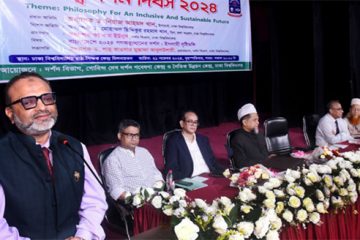Archaeologists urge govt
Archaeologists at a roundtable yesterday said Lalbagh Fort is under threat of encroachers and urged the government to protect the heritage site.
The speakers portrayed a grim picture of the famous Mughal-era palace cum fortress.
They said encroachers demolished the surviving walls on the west side, and many multi-storied buildings now stand there.
On the south side, encroachers have been using the fortress wall as a boundary for their buildings, they added.
They said a pump house and a water reservoir have been built inside the fortress boundary while garbage lies beside every wall outside the fort.
They added that originally the structure was built on 22 acres of land of which only 18 acres remain.
The roundtable was organised by Poribesh Bachao Andolon (Poba) at the National Press Club in the city.
The archaeologists said the blame does not fall on the public only and blamed the Department of Archaeology for violating the laws.
They said the department itself built a two-storied building inside the compound although the 1961 Archaeology Law clearly prohibits such construction in the territory of a heritage site.
The department also lacks professional archaeologists, restoration engineers and a proper funding, which led to the damage of the original design, they said.
Presenting the keynote paper, Prof Mainuddin Khaled said the department of archaeology destroyed the site with their restoration projects, often damaging the original artwork and colour of the fortress.
Khaled also pointed out that the recently enacted Reserved Areas for Tourism and Special Tourism Zones Act-2010 might become a threat to the fortress as it made room for the takeover of heritage sites for tourism.
Prof Dr AKM Shahnewaz, Department of Archaeology at Jahangirnagar University, said the root cause of this destruction is that people here do not take pride in historical sites and lack compassion for them.
The department’s Chairman Sufi Mostafiz said there has to be a buffer zone between a historical site and the adjacent neighbourhood, which the fortress lacks and this leaves a threat to its existence.
Mostafiz stressed that without creating empathy among the locals, it is not possible to restore the glory of the fortress. Involving the local community is necessary for that, he added.
Prof Samsuzzaman Khan, director general of Bangla Academy, Abu Naser Khan, chairman of Poba, and architect Samsul Wares also spoke on the occasion.
Construction of the fortress began in 1678. The credit goes to Prince Muhammad Azam. During his 15-month long vice-royalty of Bengal, he continued the construction but was recalled by the then emperor Aurangzeb before he could complete it.
The fortress is a witness to many historical events. Many atrocities took place in the fortress during the Sepoy Mutiny of 1857. In 1953, Pakistan soldiers led by the then GCO Ayub Khan (later president) killed many police officers for mutiny.




















